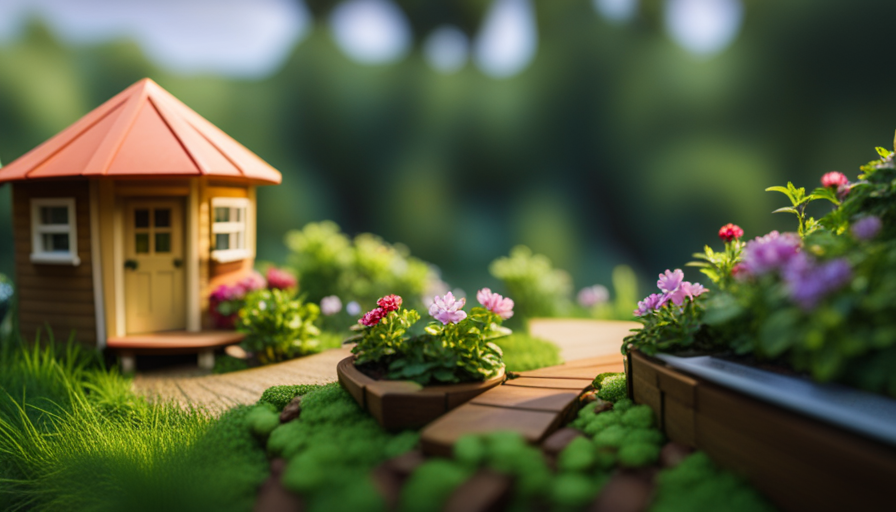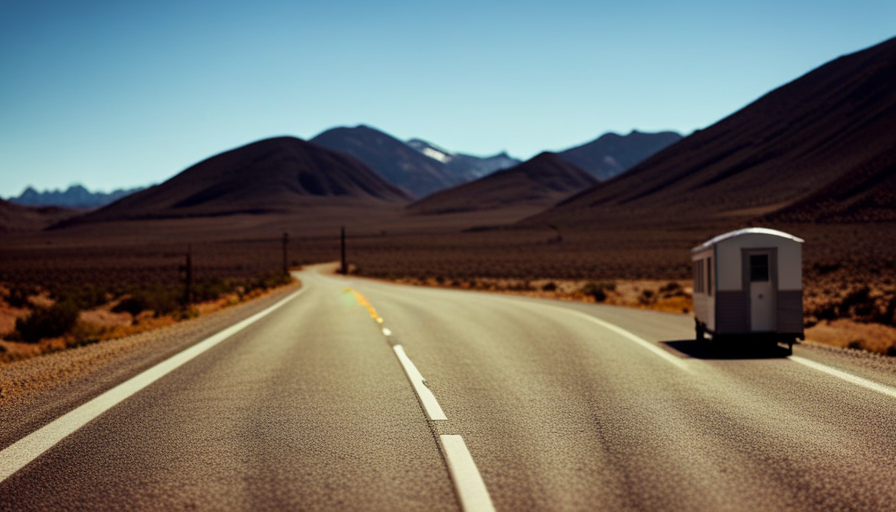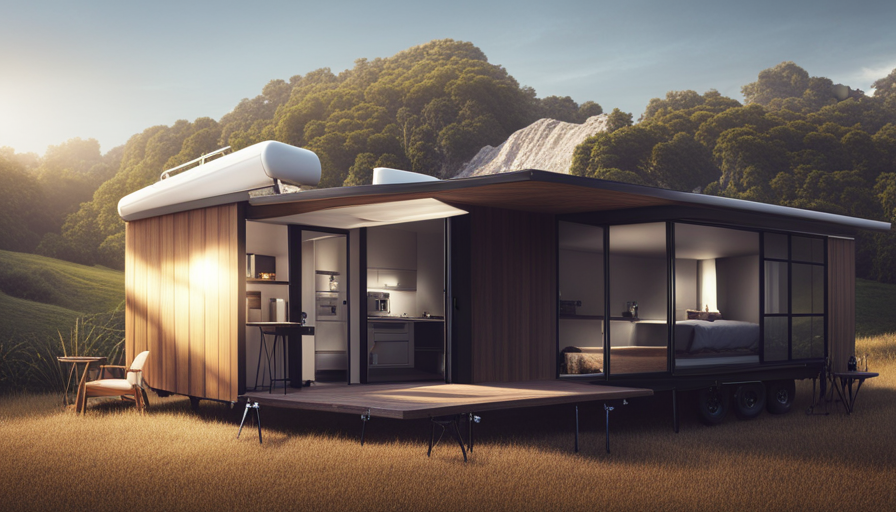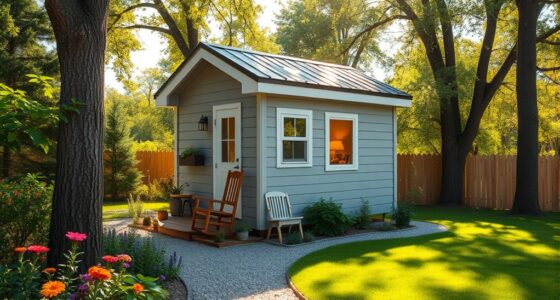Have you ever found yourself admiring a big, spacious house and thinking, “I could never afford this”? What if I told you there is a way to own a home without breaking the bank? Welcome to the tiny house movement.
Like a breath of fresh air, these pint-sized dwellings offer a simpler, more affordable alternative to traditional homes. But before you start envisioning a cramped, uncomfortable living space, let me assure you that tiny houses are anything but. With clever design and innovative use of space, these homes can be just as functional and comfortable as their larger counterparts.
But how much does it actually cost to build a tiny house? In this article, we will delve into the different types of tiny houses, the factors that affect costs, and the various expenses you need to consider. So, if you’re ready to downsize your life and build your dream tiny house, keep reading to discover the true cost of this exciting housing trend.
Key Takeaways
- The cost of building a tiny house ranges from $200 to $400 per square foot.
- Factors such as location, size, and materials can affect the cost of building a tiny house.
- Zoning regulations and permits impact the design and placement of tiny houses, particularly in urban areas.
- Financing options for building a tiny house include personal loans, mortgages, crowdfunding, and RV loans.
Types of Tiny Houses
There’s a wide range of tiny house styles to choose from, each offering unique features and designs. When it comes to tiny house designs, the possibilities are endless. You can opt for a traditional-looking tiny house with a gable roof and cedar siding, or you can go for a more modern design with sleek lines and large windows.
Some people even choose to build their tiny houses on wheels, allowing for more flexibility and the ability to travel. However, it’s important to consider zoning regulations when deciding on a tiny house design. Different areas have different rules and restrictions regarding the size and placement of tiny houses. Some places may require a minimum square footage or prohibit tiny houses altogether.
It’s crucial to research and understand the zoning regulations in your area before starting the construction process. Factors affecting costs will be discussed in the subsequent section, but it’s important to note that the type of tiny house design you choose can have a significant impact on the overall cost.
Factors Affecting Costs
Factors such as location, size, and materials used can significantly impact the overall price of constructing a small dwelling. For example, according to a study by the National Association of Home Builders, the average cost per square foot for building a tiny house can range from $200 to $400.
To better understand how these factors can affect costs, consider the following:
-
Location: The location where the tiny house is built can greatly affect the cost. Building in urban areas may require additional permits and inspections, which can increase expenses. Additionally, the cost of land or renting a space for the tiny house can vary depending on the region.
-
Size considerations: The size of the tiny house plays a crucial role in determining the overall cost. Larger tiny houses will require more materials, resulting in higher costs. Additionally, features such as multiple levels or customized designs can also impact the price.
-
Materials used: The choice of materials used for construction can significantly affect the cost. Opting for high-end, sustainable materials can increase expenses, while using more affordable options can help reduce costs.
Considering these factors, it becomes clear that the location, size, and materials used are key considerations when determining the cost of building a tiny house. In the subsequent section about materials and construction costs, we will explore these factors in more detail.
Materials and Construction Costs
Using a variety of high-quality, sustainable materials adds a touch of elegance and durability to the construction of a small dwelling. When building a tiny house, it is important to carefully consider the types of materials that will be used. The choice of materials can greatly affect both the cost and the overall quality of the house.
To give a better understanding of the costs associated with materials, I have provided a breakdown in the table below:
| Material Type | Cost per Square Foot |
|---|---|
| Framing | $10-$20 |
| Insulation | $1-$3 |
| Exterior Siding | $3-$10 |
| Roofing | $2-$6 |
These are just a few examples of the materials that will be needed during the construction process. The cost breakdown can vary depending on the specific needs and preferences of the homeowner.
Transitioning into the subsequent section about labor costs, it is important to note that while materials play a significant role in the overall cost of building a tiny house, labor costs are equally important to consider.
Labor Costs
Labor is a key component in creating a small dwelling that is both functional and aesthetically pleasing. When it comes to building a tiny house, labor costs can vary depending on factors such as location, the complexity of the design, and the experience of the laborers involved.
Here are three important things to consider when it comes to labor pricing and construction time:
-
Skill and Experience: Hiring skilled laborers who have experience in building tiny houses can ensure a higher quality of workmanship. However, their expertise may come at a higher cost compared to less experienced laborers.
-
Construction Time: The time it takes to build a tiny house can significantly impact labor costs. The longer it takes to complete the construction, the more labor hours are required, which can increase the overall price.
-
Customization and Complexity: If your tiny house design includes unique features or intricate details, it may require more labor hours to complete. This can also contribute to higher labor costs.
Considering these factors, it is important to budget for labor pricing and factor in the construction time when planning the overall cost of building a tiny house. In addition to labor costs, there are also other expenses to consider when embarking on a tiny house project, such as permits, utilities, and finishing touches.
Additional Expenses
To fully prepare for your tiny house project, it’s important to consider the various expenses that go beyond just the construction process. Additional expenses can quickly add up and significantly impact your overall budget. Let’s break down some of these costs.
One major additional expense is the cost of permits and inspections. Depending on your location, you may need to obtain permits for zoning, building, electrical, and plumbing. Each permit comes with a fee, and inspections may also incur additional charges. It’s crucial to research and budget for these expenses to avoid any surprises down the line.
Another significant cost is the purchase of land or rental of a space to place your tiny house. Land prices can vary greatly depending on the area, so it’s important to do your research and factor this into your budget.
Other additional expenses to consider include utilities such as water, electricity, and sewage connections. You may also need to invest in insurance for your tiny house and its contents.
When planning your tiny house project, it’s essential to consider the additional expenses that come with it. By budgeting for permits, land, utilities, and insurance, you can better prepare yourself financially. Now, let’s explore some financing and budgeting tips to help you make your tiny house dream a reality.
Financing and Budgeting Tips
When it comes to financing a tiny house, there are a few options to consider. One can explore traditional financing methods such as personal loans or mortgages, or they can look into alternative options like crowdfunding or RV loans.
It’s important to create a realistic budget that takes into account all the necessary expenses, including the cost of land, materials, and labor. By making smart choices and finding ways to save money, such as using reclaimed materials or doing some of the construction work yourself, it’s possible to build a tiny house on a budget.
Financing options for tiny houses
Looking to finance your tiny house? You’ll be delighted to discover there are a variety of options available to help you achieve your dream home. When it comes to tiny house loan options, there are several lenders that specialize in providing loans specifically for tiny houses. These loans typically have favorable terms and interest rates, making it easier for you to finance your project. Another popular financing option is crowdfunding for tiny houses. This allows you to reach out to a community of supporters who believe in your vision and are willing to contribute financially.
Here is a table summarizing some common financing options for tiny houses:
| Financing Option | Description | Pros |
|---|---|---|
| Tiny house loans | Loans specifically designed for tiny houses | Favorable terms and interest rates |
| Crowdfunding | Raising funds from a community of supporters | Access to a network of potential contributors |
| Personal savings | Using your own savings to fund your tiny house | No interest payments and full ownership |
| RV loans | Loans for tiny houses on wheels | Easier to qualify for and more flexible terms |
| Home equity loan | Borrowing against the equity in your current home | Lower interest rates and potential tax benefits |
Now that you know the financing options available, let’s explore creating a realistic budget for your tiny house project.
Creating a realistic budget
Financing your dream tiny home can feel like navigating a treacherous financial minefield, but fear not, for we’re about to embark on a budgeting journey that’ll make your head spin and your wallet weep.
To create a realistic budget for your tiny house, consider the following:
-
Types of designs: Explore different tiny house designs to find the one that suits your needs and budget. From traditional to modern, there are various options available that can help you save money without compromising functionality.
-
Cost-saving strategies: Implementing cost-saving strategies can significantly impact your budget. Consider using reclaimed materials, opting for energy-efficient appliances, and utilizing space-saving solutions to reduce expenses.
-
Prioritizing essential features: Identify the must-have features for your tiny house and allocate a portion of your budget accordingly. By focusing on what truly matters to you, you can avoid overspending on unnecessary elements.
As we move into the next section about saving money through smart choices, remember that every decision you make during the budgeting process plays a vital role in achieving your dream tiny house without breaking the bank.
Saving money through smart choices
To save money, consider prioritizing essential features and making smart choices throughout the budgeting process for your dream tiny home.
One way to save on utilities is to invest in energy-efficient appliances and fixtures. Look for appliances with high energy star ratings and consider installing LED lighting to reduce electricity usage.
Another money-saving option is to take on some DIY projects. You can build your own furniture, install flooring, or even construct your own kitchen cabinets. Not only will this save you money on labor costs, but it will also give you a sense of accomplishment and personalization in your tiny home.
By being strategic with your choices, you can save money without sacrificing quality.
Now, let’s discuss the hidden costs to consider in the next section.
Hidden Costs to Consider
When building a tiny house, it’s important to be aware of the hidden costs that can quickly add up. These hidden fees and unexpected expenses can catch you off guard if you’re not prepared.
One of the biggest hidden costs to consider is the land. Finding a suitable plot of land can be a challenge, and it can come with a hefty price tag.
Additionally, you may need to invest in permits and inspections, which can add to the overall cost of your tiny house project.
Another hidden cost is utilities. While tiny houses are designed to be energy-efficient, you may still need to connect to the grid or invest in alternative energy sources, such as solar panels.
Maintenance and repairs are also important to consider. Just like any other home, tiny houses require upkeep, and unexpected repairs can arise. It’s crucial to budget for these potential expenses.
Transitioning into the next section about cost comparison to traditional homes, it’s clear that building a tiny house requires careful consideration of these hidden costs, which may not be as prevalent in traditional home construction.
Cost Comparison to Traditional Homes
When considering the hidden costs of building a tiny house, it’s important to also compare the overall cost to that of traditional homes. This will give us a clearer picture of the potential savings. So, let’s dive into the cost comparison between tiny houses and traditional homes.
-
Construction Costs: While the upfront cost of building a tiny house can be lower than that of a traditional home, it’s important to consider the size difference. Building materials, labor, and permits will still incur expenses, but on a smaller scale.
-
Maintenance and Utilities: Tiny houses are generally more energy-efficient and require less maintenance compared to larger homes. This can result in significant long-term savings on utility bills and upkeep.
-
Property Taxes: The smaller footprint of a tiny house means lower property taxes in many cases. This can be a substantial cost-saving advantage over traditional homes.
-
Comparison to Renting: Renting can be expensive, especially in high-demand areas. Building a tiny house can be a cost-effective alternative, as you are building equity in your own property rather than paying rent each month.
By implementing cost-saving strategies and considering these comparisons to traditional homes, it becomes evident that building a tiny house can be a financially smart decision in the long run. Now, let’s explore some case studies and examples to further illustrate the potential benefits.
Case Studies and Examples
The financial advantages of constructing a tiny house become abundantly clear when examining real-life examples and case studies. By looking at specific instances of tiny house construction, we can see just how cost-effective and efficient these homes can be.
In order to illustrate these advantages, let’s take a look at three different case studies:
| Case Study | Location | Cost |
|---|---|---|
| Case 1 | Austin | $20k |
| Case 2 | Seattle | $25k |
| Case 3 | Portland | $30k |
Case Study 1, located in Austin, demonstrates how a tiny house can be built for a mere $20,000. This is significantly lower than the average cost of a traditional home in the area. Case Study 2, in Seattle, showcases a slightly higher cost of $25,000, but still remains considerably cheaper than the average home price in the city. Lastly, Case Study 3, located in Portland, displays a cost of $30,000, which is still a fraction of the cost of a typical home in the area.
These case studies highlight the affordability of tiny house construction and serve as prime examples of the financial benefits that can be enjoyed by opting for a tiny house lifestyle.
Frequently Asked Questions
Are tiny houses legally allowed in all areas, or are there specific zoning regulations to consider?
In urban areas, tiny house zoning regulations can vary. There are specific challenges to consider when building a tiny house, such as finding suitable land and ensuring compliance with local building codes.
How long does it typically take to build a tiny house from start to finish?
Typically, it takes around 3-6 months to build a tiny house from start to finish. However, challenges such as obtaining permits and sourcing materials can affect the timeline.
Can I customize the design and layout of my tiny house, or are there restrictions?
Yes, you can fully customize the design and layout of your tiny house. There are no restrictions when it comes to customizing your tiny house to fit your specific needs and preferences.
What are the maintenance costs associated with owning a tiny house?
The maintenance costs of owning a tiny house can vary depending on factors such as location and materials used. However, overall, tiny houses tend to have lower maintenance costs due to their smaller size and energy-efficient design.
Are there any specific insurance requirements for tiny houses, and how much does insurance typically cost?
Insurance requirements for tiny houses vary depending on location and usage. Factors affecting insurance costs include the value of the tiny house, its location, and the type of coverage needed. It is important to consult with an insurance professional for accurate cost estimates.
Conclusion
In conclusion, building a tiny house is a cost-effective and rewarding endeavor. By carefully considering the factors that affect costs, such as materials, labor, and additional expenses, one can create a beautiful and functional home.
With proper financing and budgeting, the dream of owning a tiny house can become a reality. However, it’s important to be aware of hidden costs that may arise during the construction process.
Comparatively, tiny houses offer a more affordable alternative to traditional homes, providing individuals with the opportunity to live a simpler and more sustainable lifestyle.
Hi, I’m Emma. I’m the Editor in Chief of Tiny House 43, a blog all about tiny houses. While tree houses are often associated with childhood, they can be the perfect adult retreat. They offer a cozy space to relax and unwind, surrounded by nature. And since they’re typically built on stilts or raised platforms, they offer stunning views that traditional homes simply can’t match. If you’re looking for a unique and romantic getaway, a tree house tiny house might just be the perfect option.










